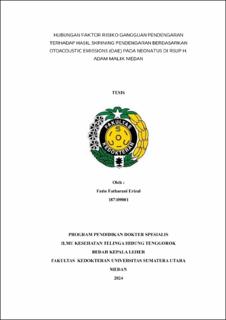Hubungan Faktor Risiko Gangguan Pendengaran terhadap Hasil Skrining Pendengaran Berdasarkan Otoacoustic Emissions (OAE) pada Neonatus di RSUP H. Adam Malik Medan
Relationship of Risk Factors For Hearing Loss to Hearing Screening Results Based on Otoacoustic Emissions (OAE) in Neonates at H. Adam Malik Hospital Medan

Date
2024Author
Erizal, Fatin Fatharani
Advisor(s)
Herwanto, Yusa
Sofyan, Ferryan
Metadata
Show full item recordAbstract
Introduction: Neonates in the Neonatal Intensive Care Unit (NICU) have a higher incidence of hearing impairment (20 to 50 per 1,000 newborns) compared to normal neonates.
Objectives: This study aimed to investigate the relationship between risk factors for hearing impairment and hearing screening results based on Otoacoustic Emissions (OAE) in neonates at H. Adam Malik General Hospital, Medan.
Methods: This cross-sectional study included 52 neonates (aged 0-28 days) admitted to the Perinatology room of the Department of Child Health at H. Adam Malik General Hospital. Risk factors such as gestational age, birth weight, hyperbilirubinemia, APGAR score, length of stay, and aminoglycoside administration were assessed. Hearing screening was performed using OAE.
Results: The mean age of neonates was 6.96 days, with 53.8% males and 46.2% females. Most mothers (61.5%) had a gestational age of 36-39 weeks. Low birth weight (< 1,500 grams) was found in 25% of neonates, hyperbilirubinemia in 38.5%, APGAR score < 5 in 44.2%, length of stay > 5 days in 25%, and aminoglycoside administration for > 5 days in 7.7%. OAE screening showed a refer result in 34.6% of neonates. No significant associations were found between gestational age (p=0.175), birth weight (p=0.343), hyperbilirubinemia (p=0.213), APGAR score (p=0.542), length of stay (p=0.334), or the number of risk factors (p=0.171) and OAE screening results.
Conclusion: Although a considerable proportion of neonates had risk factors for hearing impairment, no significant associations were found between these factors and OAE screening results in this study. Further research with a larger sample size and additional risk factors may provide more conclusive evidence on the relationship between risk factors and hearing impairment in neonates.
Collections
- Master Theses [204]
